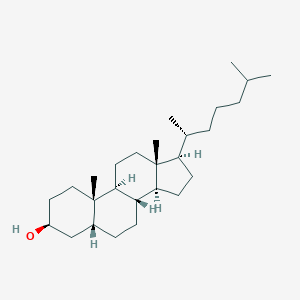| General Information of MET (ID: META00274) |
| Name |
5-Beta-Coprostanol
|
| Synonyms |
Click to Show/Hide Synonyms of This Metabolite
(3beta,5beta)-Cholestan-3-ol; 3b-Hydroxy-5b-cholestanol; 5 alpha Cholestan 3 alpha ol; 5 alpha Cholestan 3 beta ol; 5 alpha-Cholestan-3 alpha-ol; 5 alpha-Cholestan-3 beta-ol; 5 beta Cholestan 3 beta ol; 5 beta-Cholestan-3 alpha-ol; 5 beta-Cholestan-3 beta-ol; 5beta Coprostanol; 5beta-Cholestan-3beta-ol; Cholestan 3 ol; Cholestan-3-ol; Cholestanol; Cholestanol, (3alpha, 5beta)-isomer; Coprostanol; Coprosterol; Dihydrocholesterol; Stercorin; beta Cholestanol; beta-Cholestan-3 beta-ol, 5; beta-Cholestanol; beta-Ol, 5 beta-cholestan-3
|
| Source |
Endogenous;Sterol lipids;Food
|
| Structure Type |
Cholestane steroids (Click to Show/Hide the Complete Structure Type Hierarchy)
Lipids and lipid-like molecules
Steroids and steroid derivatives
Cholestane steroids
|
| PubChem CID |
|
| HMDB ID |
|
| Formula |
C27H48O
|
| Structure |
<iframe style="width: 300px; height: 300px;" frameborder="0" src="https://embed.molview.org/v1/?mode=balls&cid=221122"></iframe>
|
 |
|
3D MOL
|
2D MOL
|
|
Click to Show/Hide the Molecular/Functional Data (External Links/Property/Function) of This Metabolite
|
| ChEBI ID |
|
| FooDB ID |
|
| ChemSpider ID |
|
| METLIN ID |
|
| Physicochemical Properties |
Molecular Weight |
388.7 |
Topological Polar Surface Area |
20.2 |
| XlogP |
9.4 |
Complexity |
540 |
| Heavy Atom Count |
28 |
Rotatable Bond Count |
5 |
| Hydrogen Bond Donor Count |
1 |
Hydrogen Bond Acceptor Count |
1 |
| Function |
Coprosterol or coprostanol is a cholesterol derivative found in human feces, gallstones, eggs, and other biological matter. Coprosterol is the odorous principle of feces. It is formed from the biohydrogenation of cholesterol (cholest-5en-3β-ol) in the gut of most higher animals and birds. This compound has frequently been used as a biomarker for the presence of human faecal matter in the environment. American physician Austin Flint named it stercorin. The transformation of cholesterol into coprosterol in its passage through the body involves a reduction of the C5:C6 double bond, and a transition from the allocholanic- to the cholanic-ring system. Although it is established that the bacterial flora of the intestine is concerned in the reduction process, the mechanism by which the stereochemical change is brought about is unknown. Current data suggests that cholestenone and coprostanone, and not cholesterol itself, are the immediate precursors of coprosterol which is formed from them in the intestine by bacterial reduction. Coprosterol is also a microbial metabolite, it can be produced by Lactobacillus.
|
|
Regulatory Network
|
|
|
|
|
|
|
|
|
 click to show the details of this protein
click to show the details of this protein
 click to show the details of experiment for validating this pair
click to show the details of experiment for validating this pair

